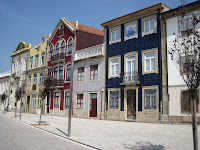It was only a short 3 hour hop from Povoa De Varzim to Leixoes and we had wind, but we could’nt get the pin our of old Harry so had to hand steer Rapau. The weather was very poor and cold and we anchored in the harbour which is very industrial, so just an overnighter and leave early next day was in order. Having fixed the problem with Old Harry (a bent pin), we were Ok for the 8 hour sail from Leixoes to Aveiro, only there was no wind so we had to motor all the way!
Aveiro
Rapau in Sae Jacinto Bay
The harbour of Sao Jacinto in the Aveiro estuary was very peaceful. The estuary is made up of salt marshes and sand spits so careful navigation was needed. We had to be at the entrance shortly before high water or it would be dangerous to enter as the tide can run at up to 8 knots through there and according to the pilot book a yacht was lost there in 1999 trying to enter in a 3m swell. Sao Jacinto itself had a military base and not much else, there was a small grocery shop with mostly empty shelves but Keith did find one with beer as stocks were low on the boat! We took a ferry and bus to the town of Aveiro which was very ‘Venice-esk’. There were trippeer boats that looked like gondolas going up and down the river.
The ferry from Sao Jacinto to Aveiro
Aveiro river looking very Venice-like.
Figueira da Foz
Another 8hour on the engine as no wind again (thought this was a sailing trip!) to Figueira da Foz were we were forced to go into the most expensive marina we have come across as no anchoring permitted in the harbour. It was also the most tatty marina and facilities with no help from the staff, no wi-fi , they would take only cash as the card machine was not working and the last weather forecast posted up was 2 September (this was 20 September!)
Nazare
7 hours down the coast was the seaside town of Nazare, there we were met by Captain Michael Hadley an old Captain Birds Eye look–alike who was standing on the pontoon (only marina berthing again) with a pipe in his mouth and waving madly at us with some kind of signals that we did not understand. This eccentric Welshman and his wife came into Nazare to shelter from a storm 10 years ago on their way back from the Mediterranean and have never left. He gave us instructions about everything and during our 2 day stay we watched him see people in, walk around and tell people off and generally own the marina. He was very helpful and obliging however, as Keith did an oil change and needed to get hold of oil and filters and he gave us lots of information. We also went up the furnicular railway while we there and looked at the magnificent view from the top of the cliffs.
We were tied up right next to the fishing quay in Nazaire
View of Nazaire harbour from top of the cliff
View of people from the top of the cliff!
Sao Martinho do Porto and Peniche
Next stop was in the wave excavated bay of Sao Martinho do Porto. We just stayed the night where we rolled around at anchor. The entrance is very narrow and the pilot book warned about the dangers of trying to leave in a swell so we got out asap (remember here the swell has the whole of the Atlantic to build up the fetch!) Peniche was the next stop, again just for a night at anchor.


The narrow entrance to Sao Martinho do Porto that can be dodgy to leave
Lisbon
We passed Cabo de Roca which is the most westerly point of mainland Europe before we finally reached the entrance to the Rio Tejo on which Lisbon sits on 26 September. There is a lovely big anchorage were we anchored at Cascais, a town in the approaches to the river. The weather is definitely hotter and more settled, roll on getting even further south!!
Cabo de Roca, the most westerly point of mainland Europe
The anchorage at Cascaise





.JPG)
.JPG)



















.JPG)

.JPG)








